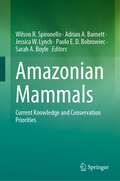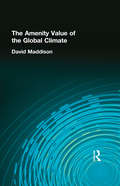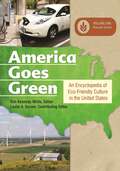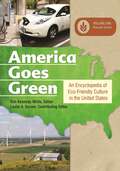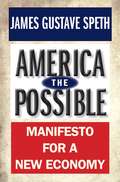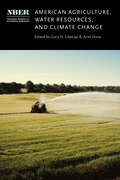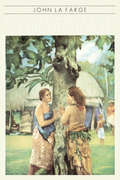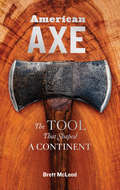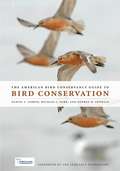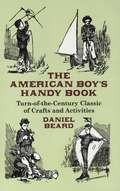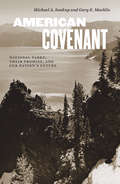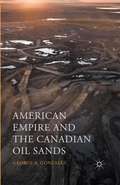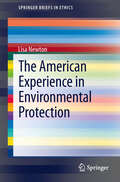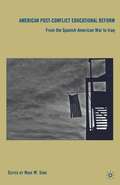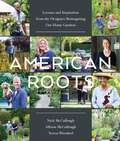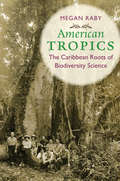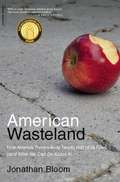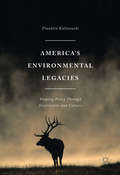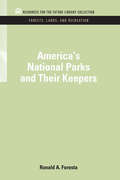- Table View
- List View
Amazonian Mammals: Current Knowledge and Conservation Priorities
by Wilson R. Spironello Adrian A. Barnett Jessica W. Lynch Paulo E. D. Bobrowiec Sarah A. BoyleThe mammal fauna of the Brazilian Amazon is one of the most diverse on Earth with over 450 known species. Bringing together more than 70 of the world’s top experts on Amazonian mammals, this book unites, for the first time, up-to-date data on the current state of knowledge on the ecology of all groups of non-rodent mammals in the Brazilian Amazon, analyses the effectiveness of current conservation programmes and identifies research and conservation priorities for the future.
The Amenity Value of the Global Climate
by David MaddisonThis text develops and applies a far-reaching account of the economic value of climate, derived from its amenity value or the benefits which a particular climate provides to the people of that region or country. As climate change moves higher on the economic and political agendas, reliable measures of the benefits and costs of specific climates and changes to them become ever-more critical. Detailed studies of a range of countries including Britain, the US, India and Russia, show that the mobility of the population is crucial. When individuals are able to move, the amenity value of the climate is reflected in land prices and wage rates. Without mobility, amenity values emerge in patterns of purchasing, either to compensate for the disadvantages of the climate or to make best use of it. Indices are generated for the cost of living as a function of climate variables, and optimal climates are identified to determine who wins and who loses from climate change.
The Amenity Value of the Global Climate
by David MaddisonThis text develops and applies a far-reaching account of the economic value of climate, derived from its amenity value or the benefits which a particular climate provides to the people of that region or country. As climate change moves higher on the economic and political agendas, reliable measures of the benefits and costs of specific climates and changes to them become ever-more critical. Detailed studies of a range of countries including Britain, the US, India and Russia, show that the mobility of the population is crucial. When individuals are able to move, the amenity value of the climate is reflected in land prices and wage rates. Without mobility, amenity values emerge in patterns of purchasing, either to compensate for the disadvantages of the climate or to make best use of it. Indices are generated for the cost of living as a function of climate variables, and optimal climates are identified to determine who wins and who loses from climate change.
America Goes Green [3 volumes]: An Encyclopedia of Eco-Friendly Culture in the United States [3 volumes]
by Leslie A. DuramThis three-volume encyclopedia explores the evolution of green ideology and eco-friendly practices in contemporary American culture, ranging from the creation of regional and national guidelines for green living to the publication of an increasing number of environmental blogs written from the layperson's perspective.Evidence of humanity's detrimental impact on the environment is mounting. As Americans, we are confronted daily with news stories, blogs, and social media commentary about the necessity of practicing green behaviors to offset environmental damage. This essential reference is a fascinating review of the issues surrounding green living, including the impact of this lifestyle on Americans' time and money, the information needed to adhere to green principles in the 21st century, and case studies and examples of successful implementation.America Goes Green: An Encyclopedia of Eco-Friendly Culture in the United States examines this gripping topic through 3 volumes organized by A–Z entries across 11 themes; state-by-state essays grouped by region; and references including primary source documents, bibliography, glossary, and green resources. This timely encyclopedia explores the development of an eco-friendly culture in America, and entries present the debates, viewpoints, and challenges of green living.
America Goes Green [3 volumes]: An Encyclopedia of Eco-Friendly Culture in the United States [3 volumes]
by Leslie A. DuramThis three-volume encyclopedia explores the evolution of green ideology and eco-friendly practices in contemporary American culture, ranging from the creation of regional and national guidelines for green living to the publication of an increasing number of environmental blogs written from the layperson's perspective.Evidence of humanity's detrimental impact on the environment is mounting. As Americans, we are confronted daily with news stories, blogs, and social media commentary about the necessity of practicing green behaviors to offset environmental damage. This essential reference is a fascinating review of the issues surrounding green living, including the impact of this lifestyle on Americans' time and money, the information needed to adhere to green principles in the 21st century, and case studies and examples of successful implementation.America Goes Green: An Encyclopedia of Eco-Friendly Culture in the United States examines this gripping topic through 3 volumes organized by A–Z entries across 11 themes; state-by-state essays grouped by region; and references including primary source documents, bibliography, glossary, and green resources. This timely encyclopedia explores the development of an eco-friendly culture in America, and entries present the debates, viewpoints, and challenges of green living.
America the Possible: Manifesto for a New Economy
by James Gustave SpethIn this third volume of his award-winning American Crisis series, James Gustave Speth makes his boldest and most ambitious contribution yet. He looks unsparingly at the sea of troubles in which the United States now finds itself, charts a course through the discouragement and despair commonly felt today, and envisions what he calls America the Possible, an attractive and plausible future that we can still realize.The book identifies a dozen features of the American political economy—the country's basic operating system—where transformative change is essential. It spells out the specific changes that are needed to move toward a new political economy—one in which the true priority is to sustain people and planet. Supported by a compelling "theory of change" that explains how system change can come to America, the book also presents a vision of political, social, and economic life in a renewed America. Speth envisions a future that will be well worth fighting for. In short, this is a book about the American future and the strong possibility that we yet have it in ourselves to use our freedom and our democracy in powerful ways to create something fine, a reborn America, for our children and grandchildren.
American Agriculture, Water Resources, and Climate Change (National Bureau of Economic Research Conference Report)
by Gary D. Libecap and and Ariel DinarA collection of the most advanced and authoritative agricultural-economic research in the face of increasing water scarcity. Agriculture has been critical in the development of the American economy. Except in parts of the western United States, water access has not been a critical constraint on agricultural productivity, but with climate change, this may no longer be the case. This volume highlights new research on the interconnections between American agriculture, water resources, and climate change. It examines climatic and geologic factors that affect the agricultural sector and highlights historical and contemporary farmer responses to varying conditions and water availability. It identifies the potential effects of climate change on water supplies, access, agricultural practices, and profitability, and analyzes technological, agronomic, management, and institutional adjustments. Adaptations such as new crops, production practices, irrigation technologies, water conveyance infrastructure, fertilizer application, and increased use of groundwater can generate both social benefits and social costs, which may be internalized with various institutional innovations. Drawing on both historical and present experiences, this volume provides valuable insights into the economics of water supply in American agriculture as climate change unfolds.
American Agriculture, Water Resources, and Climate Change (National Bureau of Economic Research Conference Report)
by Gary D. Libecap Ariel DinarA collection of the most advanced and authoritative agricultural-economic research in the face of increasing water scarcity. Agriculture has been critical in the development of the American economy. Except in parts of the western United States, water access has not been a critical constraint on agricultural productivity, but with climate change, this may no longer be the case. This volume highlights new research on the interconnections between American agriculture, water resources, and climate change. It examines climatic and geologic factors that affect the agricultural sector and highlights historical and contemporary farmer responses to varying conditions and water availability. It identifies the potential effects of climate change on water supplies, access, agricultural practices, and profitability, and analyzes technological, agronomic, management, and institutional adjustments. Adaptations such as new crops, production practices, irrigation technologies, water conveyance infrastructure, fertilizer application, and increased use of groundwater can generate both social benefits and social costs, which may be internalized with various institutional innovations. Drawing on both historical and present experiences, this volume provides valuable insights into the economics of water supply in American agriculture as climate change unfolds.
American Artist In The South Sea
by John La FargeThe American artists John La Farge preceded Gauguin to the Pacific, and in their time his reputation as the modern Pacific painter far overshadowed that of the Frenchman. This remarkable work is the record of a year-long artistic odyssey through the South Seas, during which La Farge braved the volcanoes of Hawaii, visited Robert Louis Stevenson in Samoa, was adopted by a noble Tahitian family and journeyed through the wild hills of Fiji, painting and sketching lyrical studies of island life. Lavishly illustrated with his work, this account of the Polynesian adventures that La Farge shared with his friend the historian Henry Adams is an important contribution to the literary and artistic heritage of the Pacific and a revealing insight into the life of a complex and fascinating man.
American Artist In The South Sea
by John La FargeThe American artists John La Farge preceded Gauguin to the Pacific, and in their time his reputation as the modern Pacific painter far overshadowed that of the Frenchman. This remarkable work is the record of a year-long artistic odyssey through the South Seas, during which La Farge braved the volcanoes of Hawaii, visited Robert Louis Stevenson in Samoa, was adopted by a noble Tahitian family and journeyed through the wild hills of Fiji, painting and sketching lyrical studies of island life. Lavishly illustrated with his work, this account of the Polynesian adventures that La Farge shared with his friend the historian Henry Adams is an important contribution to the literary and artistic heritage of the Pacific and a revealing insight into the life of a complex and fascinating man.
American Axe: The Tool That Shaped a Continent
by Brett McLeodWoodsman and forester Brett McLeod pays tribute to the axe with stunning photography and illuminating text that traces this historic hand tool&’s evolution in form and function through North American culture and history.
The American Bird Conservancy Guide to Bird Conservation
by Daniel J. Lebbin Michael J. Parr George H. FenwickWhether we live in cities, in the suburbs, or in the country, birds are ubiquitous features of daily life, so much so that we often take them for granted. But even the casual observer is aware that birds don’t fill our skies in the number they once did. That awareness has spawned conservation action that has led to notable successes, including the recovery of some of the nation’s most emblematic species, such as the Bald Eagle, Brown Pelican, Whooping Crane, and Peregrine Falcon. Despite this, a third of all American bird species are in trouble—in many cases, they’re in imminent danger of extinction. The most authoritative account ever published of the threats these species face, The American Bird Conservancy Guide to Bird Conservation will be the definitive book on the subject. The Guide presents for the first time anywhere a classification system and threat analysis for bird habitats in the United States, the most thorough and scientifically credible assessment of threats to birds published to date, as well as a new list of birds of conservation concern. Filled with beautiful color illustrations and original range maps, the Guide is a timely, important, and inspiring reference for birders and anyone else interested in conserving North America’s avian fauna. But this book is far more than another shout of crisis. The Guide also lays out a concrete and achievable plan of long-term action to safeguard our country’s rich bird life. Ultimately, it is an argument for hope. Whether you spend your early weekend mornings crouched in silence with binoculars in hand, hoping to check another species off your list, or you’ve never given much thought to bird conservation, you’ll appreciate the visual power and intellectual scope of these pages.
The American Bird Conservancy Guide to Bird Conservation
by Daniel J. Lebbin Michael J. Parr George H. FenwickWhether we live in cities, in the suburbs, or in the country, birds are ubiquitous features of daily life, so much so that we often take them for granted. But even the casual observer is aware that birds don’t fill our skies in the number they once did. That awareness has spawned conservation action that has led to notable successes, including the recovery of some of the nation’s most emblematic species, such as the Bald Eagle, Brown Pelican, Whooping Crane, and Peregrine Falcon. Despite this, a third of all American bird species are in trouble—in many cases, they’re in imminent danger of extinction. The most authoritative account ever published of the threats these species face, The American Bird Conservancy Guide to Bird Conservation will be the definitive book on the subject. The Guide presents for the first time anywhere a classification system and threat analysis for bird habitats in the United States, the most thorough and scientifically credible assessment of threats to birds published to date, as well as a new list of birds of conservation concern. Filled with beautiful color illustrations and original range maps, the Guide is a timely, important, and inspiring reference for birders and anyone else interested in conserving North America’s avian fauna. But this book is far more than another shout of crisis. The Guide also lays out a concrete and achievable plan of long-term action to safeguard our country’s rich bird life. Ultimately, it is an argument for hope. Whether you spend your early weekend mornings crouched in silence with binoculars in hand, hoping to check another species off your list, or you’ve never given much thought to bird conservation, you’ll appreciate the visual power and intellectual scope of these pages.
The American Boy's Handy Book: Turn-of-the-Century Classic of Crafts and Activities
by Daniel BeardAs timely as it is timeless, this instructive book has captured the interest and imagination of boys for well over a century. Chapters on kite flying and fishing, rigging and sailing small boats, camping out without a tent, knot-tying for mountain climbing and other activities, as well as training dogs, raising wild birds, and other projects will appeal as much to today's youngsters as they did to children in the late 1800s. This classic includes scores of projects that will keep children occupied all year long ― from sculpting snowmen and making sleds to stocking aquariums and performing puppet shows. Many of these enterprises have also been known to compete effectively with TV and video games! Best of all, the projects have the power to inspire the imagination and help youngsters master new skills and experience the satisfaction of personal accomplishment.
American Covenant: National Parks, Their Promise, and Our Nation's Future
by Michael Soukup Gary E MachlisAn intimate and candid account of our national parks and their strengths, vulnerabilities, and essential role in American life Part memoir, part critique, and paean to the value of national parks, American Covenant distills the experience and insights from two long careers in conservation. Michael A. Soukup and Gary E. Machlis show how the national parks are essential to maintaining the essence of our national heritage, and key to America’s future in a changing climate and political landscape. Sharing real-world examples of both victories and defeats in protecting national parks, this candid, thoughtful book reminds us that the national parks are a promise—a covenant—within and between generations of Americans. The book is also a call to revitalize, reconstitute, reconfigure, and reform the National Park Service, which the authors believe is governed too much by outdated management practices and politics instead of a foundation of expertise and science.
American Empire and the Canadian Oil Sands
by George A. GonzalezThroughout the US oil and gas shale are being 'hydrofracked' to produce petroleum and natural gas. Oil (or tar) sands from Canada is being 'processed' – thereby generating large amounts of crude. This book places the unconventional fossil fuels revolution that is taking place in North America within the context of great power politics.
The American Experience in Environmental Protection (SpringerBriefs in Ethics #6)
by Lisa NewtonThis book tracks the growth of environmental awareness and conservation in the United States through the major trends of the 20th century, and establishes a philosophical ground for protection of the environment. It records a major cultural shift in the thinking of this nation, and provides guidelines for its continuation.
American Post-Conflict Educational Reform: From the Spanish-American War to Iraq
by N. SobeThis edited volume brings together historians of education and comparative education researchers to study the educational reconstruction projects that Americans have launched in post-conflict settings across the globe.
American Roots: Lessons and Inspiration from the Designers Reimagining Our Home Gardens
by Nick McCullough Allison McCullough Teresa Woodard&“I love this book. Here are home gardens of designers from every part of our great country that are inspiring proof of a passionate vitality and freshness in American gardening today.&” — Page Dickey, author of Uprooted In recent years, bold designers have begun championing an American design aesthetic that embraces regional cultures, plants, and growing conditions. In American Roots, Nick McCullough, Allison McCullough, and Teresa Woodard highlight designers and creatives with exceptional home gardens, focused on those who push the boundaries, trial extraordinary plants, embrace a regional ethos, and express their talents in highly personal ways. Covering all the regions of the country, the profiles dive into design influences, share the back stories of the gardens and their creators, and include design tips and plant suggestions. American Roots is a beautiful invitation to reconsider how we define the American garden, filled with guidance and encouragement for anyone looking to dig more deeply into their own home garden.
American Tropics: The Caribbean Roots of Biodiversity Science (Flows, Migrations, and Exchanges)
by Megan RabyBiodiversity has been a key concept in international conservation since the 1980s, yet historians have paid little attention to its origins. Uncovering its roots in tropical fieldwork and the southward expansion of U.S. empire at the turn of the twentieth century, Megan Raby details how ecologists took advantage of growing U.S. landholdings in the circum-Caribbean by establishing permanent field stations for long-term, basic tropical research. From these outposts of U.S. science, a growing community of American "tropical biologists" developed both the key scientific concepts and the values embedded in the modern discourse of biodiversity.Considering U.S. biological fieldwork from the era of the Spanish-American War through the anticolonial movements of the 1960s and 1970s, this study combines the history of science, environmental history, and the history of U.S.–Caribbean and Latin American relations. In doing so, Raby sheds new light on the origins of contemporary scientific and environmentalist thought and brings to the forefront a surprisingly neglected history of twentieth-century U.S. science and empire.
American Wasteland: How America Throws Away Nearly Half of Its Food (and What We Can Do About It)
by Jonathan BloomWhat Tom Vanderbilt did for traffic and Brian Wansink did for mindless eating, Jonathan Bloom does for food waste. The topic couldn't be timelier: As more people are going hungry while simultaneously more people are morbidly obese, American Wasteland sheds light on the history, culture, and mindset of waste while exploring the parallel eco-friendly and sustainable-food movements. As the era of unprecedented prosperity comes to an end, it's time to reexamine our culture of excess.Working at both a local grocery store and a major fast food chain and volunteering with a food recovery group, Bloom also interviews experts-from Brian Wansink to Alice Waters to Nobel Prize-winning economist Amartya Sen-and digs up not only why and how we waste, but, more importantly, what we can do to change our ways.
American Wasteland: How America Throws Away Nearly Half of Its Food (and What We Can Do About It)
by Jonathan BloomWhat Tom Vanderbilt did for traffic and Brian Wansink did for mindless eating, Jonathan Bloom does for food waste. The topic couldn't be timelier: As more people are going hungry while simultaneously more people are morbidly obese, American Wasteland sheds light on the history, culture, and mindset of waste while exploring the parallel eco-friendly and sustainable-food movements. As the era of unprecedented prosperity comes to an end, it's time to reexamine our culture of excess.Working at both a local grocery store and a major fast food chain and volunteering with a food recovery group, Bloom also interviews experts-from Brian Wansink to Alice Waters to Nobel Prize-winning economist Amartya Sen-and digs up not only why and how we waste, but, more importantly, what we can do to change our ways.
America's Environmental Legacies: Shaping Policy through Institutions and Culture
by Franklin KalinowskiThis powerful book focuses on the capacity of the American political system to respond to ecological challenges through policy perspectives, the constraints of our written Constitution, and the determination we muster to address these tests of national character. Put simply, this is a book about politics, policy, and political will. Kalinowski brilliantly shows that America’s collective will is found in the cultural values enunciated by the Founding Fathers and passed down through history with modifications. It comprises the essential missing ingredient in determining how we currently respond to crises. Thomas Jefferson, Alexander Hamilton, and James Madison had distinct ideas concerning the role that Nature might play in the future. Recognizing the origins and impacts of their environmental legacies is the key to interpreting where American environmental politics is today, how we got here, and where we might be headed.
America's National Parks and Their Keepers (RFF Forests, Lands, and Recreation Set)
by Ronald A. ForestaFirst Published in 2011. Routledge is an imprint of Taylor & Francis, an informa company.
America's National Parks and Their Keepers (RFF Forests, Lands, and Recreation Set)
by Ronald A. ForestaFirst Published in 2011. Routledge is an imprint of Taylor & Francis, an informa company.
